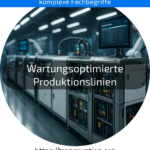The term "maintenance-optimised production lines" originates primarily from the fields of automation, industry and Factory 4.0 as well as the Internet of Things. It describes modern production lines that are designed in such a way that maintenance work can be carried out easily, quickly and, if possible, without interrupting production.
In traditional factories, machines often had to stand idle for long periods of time in order to be cleaned, repaired or checked. Maintenance-optimised production lines, on the other hand, use sensors and smart software to indicate in good time when and where maintenance is required. This allows technicians to intervene in a targeted manner before a breakdown occurs and production continues to run smoothly.
A practical example: In a car factory, a sensor on a conveyor system signals that a component needs to be replaced soon. This means that maintenance can be carried out during a planned break instead of the entire production coming to an unexpected standstill. In this way, companies save costs and ensure greater reliability.
Maintenance-optimised production lines are an important building block for more efficient, digital factories and help to secure competitiveness in the long term.






